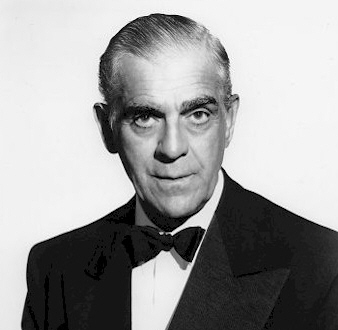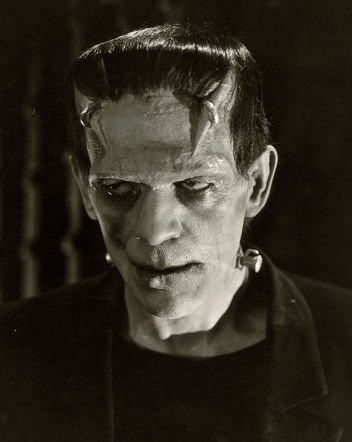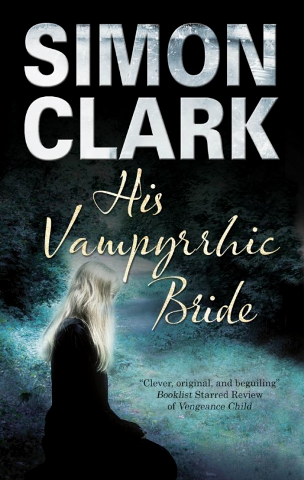

On this month's Special Page:
Award winning British author Simon Clark
tells us how Boris Karloff changed his life
IN THE "SPECIAL PAGE" ARCHIVES:
Bentley Little
David Brin
Bill Hinzman by John Russo
Earl Hamner
John Saul
Piers Anthony
Kasey Lansdale
Nancy Holder
Craig Spector
IT’S ALIVE!
Horror author Simon Clark wanted to be Boris Karloff’s Frankenstein monster when he was eleven; by the time he was eighteen he was writing monster stories. Now he admits that Karloff helped set him on the road to PURE HORROR.
This is why Simon Clark thinks Karloff is so bloody good.

One day in Hollywood in the 1920’s Lon Chaney gave a lift in his car to an unknown English actor who was so disillusioned by his struggle to make it in the movies that he was close to quitting. The actor was Boris Karloff. Chaney offered the actor some advice that would change the Englishman’s career. “The trick in this business,” Chaney explained, “is to do something totally different from the rest, so they’ll take notice of you.”
At that time Lon Chaney was THE horror actor in Hollywood. If there was going to be a horror movie then producers knew damn-well that they must have Chaney playing the monster. Ironically, the brilliant star of silent horrors had to die in order for what we consider now to be classic horror cinema to be born. Tod Browning wanted Chaney to play Dracula in his horror talkie of the same name. But Chaney developed lung cancer and died in 1930 at the peak of his powers.
A year later Dracula opened on Valentine’s Day with Lugosi, not Chaney, as the evil count. Our Dracula stereotype was born: ask passers-by their idea of a vampire and they’ll describe a darkly romantic figure with a sensual Hungarian accent. “I vont—to drink—your blo-orr-rd…”
We can only imagine how the Colorado-born Chaney, with a propensity for playing gritty, slow-burn menace, would have interpreted the character. But Chaney was dead. Lugosi gave us the kind of vampire we know today.
James Whale might never have wanted Chaney in the role of the monster in his 1931 version of Frankenstein —although he actually asked Lugosi, who turned it down. But I’d bet good money that if Chaney had survived, Whale would have been pressured by the studios to hand the role to that brilliant star of Phantom of the Opera and The Hunchback of Notre Dame. Of course, Chaney would have created his own Frankenstein monster make-up for the role—something he did in all his films. So much for what could have been… Chaney was dead. And Lugosi rejected the monster role.
Whale opted for the little known Englishman, Karloff.
Boris Karloff would become screen monster, movie icon, legend: the creature created not by God, nor Nature, but by a man of science, Baron Victor Frankenstein.
It’s all in the horror movie books under F for Frankenstein: the story critique, make-up man Jack Pierce’s creation of the monster’s flattened forehead and neck bolts, and James Whale’s dark wit and directorial panache. But the real question for me is what impact did Frankenstein and The Bride of Frankenstein have on you when you first saw them?
I watched them alone on television when I was aged eleven. At that point I didn’t care about lighting, camera angles or the Gothic sets. Until the monster made its appearance, Frankenstein was just another old black and white film.
But with the appearance of Karloff’s Frankenstein monster, WHAM!
It was like rusty old iron being transmuted into gold. With the animation of that confabulation of corpse, parts of the film came to life. The mesmerizing power of Karloff shines through the makeup. He was more than just a monster. For an eleven-year-old on the brink of puberty, the dead-made-alive man found an echo inside me. I was being transformed from a boy into a potent creature— an experience that was both frightening and exciting.
Karloff’s Frankenstein became a weirdly distorted mirror image. It wasn’t—WASN’T—just a raving, destructive monster. The creature was deeply personal to me. A kind of coded message. In some ways the monster is as vulnerable and as naive as a child, but when provoked, exhibits a superhuman strength and effortlessly destroys his foes. And boy-oh-boy when I was eleven, I wanted to be the Frankenstein monster as so sensitively played by Boris Karloff.
If anything, Karloff is even better in the sequel, The Bride of Frankenstein. The lighting, the sets, the supporting cast are all great, of course, especially the fiendishly camp Dr. Praetorius with his miniature people in glass jars, but again it’s Karloff’s towering performance that raises the film to realm all of its own. Karloff conveys a touching vulnerability and a simple need for human companionship wrapped in a monstered shell of corpse flesh. He projects an aching loneliness yet at every turn he is despised, reviled and attacked by people who judge him by his physical appearance not by his character. If the viewer hasn’t got the point, Whale drives it home by having the monster bound to a cross with its not so subliminal message of the crucifixion of an innocent, who is, perhaps, too good for this world after all.
There you have it. That’s why I think Boris Karloff is so bloody brilliant. Just say the name Karloff to me and immediately I play those scenes in my head—Frankenstein’s monster lumbering through a stygian night as lightning sears the sky, and the baroque graveyard that he senses is his real home. Karloff is the towering colossus who, while we have the ability to press the play button on our DVD player, will never die… and rightly so.



BEST NOVELLA 2011: Humpty’s Bones, Simon Clark (Telos)
Get to know Simon Clark HERE

About Simon Clark
SIMON CLARK lives in Doncaster, England with his family. When his first novel, Nailed by the Heart, made it through the slush pile in 1994 he banked the advance and embarked upon his dream of becoming a full-time writer. Many dreams and nightmares later he wrote the cult zombie classics Blood Crazy, Darkness Demands, This Rage of Echoes and The Night of the Triffids, which continues the story of Wyndham’s classic The Day of the Triffids. His revival of the wickedly ambulatory plants won the British Fantasy Society’s award for best novel.
More recently, Humpty's Bones won the British Fantasy Society’s award for best novella in 2011.
Simon has returned to the much-loved Vampyrrhic mythology with His Vampyrrhic Bride and Whitby Vampyrrhic. He has also published The Midnight Man, a story of murder, madness and ghosts, featuring Vincent Van Gogh in the most turbulent year of his life; and Ghost Monster, about opening graves in a cemetery for an archaeological dig.
Simon also experiments in short film, one of which, Dear Simon, Where Do You Get Your Ideas From? has been featured in the UK’s Channel 4 ShortDoc series, and earned the accolade ‘the ultimate in TV democracy.’ He also created Winter Chills for BBC TV. More films, with tips on writing horror fiction, plus articles, stories and Simon Clark news can be accessed at his website.
Simon’s Website www.bbr-online.com/nailed
See all of Simon's books HERE.


